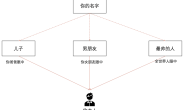作者:Grey
原文地址:
语雀
博客园
依赖查找
Spring IoC 依赖查找分为以下几种方式
-
根据 Bean 名称查找
- 实时查找
- 延迟查找
-
根据 Bean 类型查找
- 单个 Bean 对象
- 集合 Bean 对象
-
根据 Bean 名称 + 类型查找
-
根据 Java 注解查找
- 单个 Bean 对象
- 集合 Bean 对象
以下示例基于spring-framework 5.2.13.RELEASE 版本, 通过Maven管理项目
根据Bean名称实时查找
pom.xml 文件引入如下依赖
<dependency>
<groupId>org.springframework</groupId>
<artifactId>spring-context</artifactId>
</dependency>
定义一个User作为Domain
public class User {
private Long id;
private String name;
// set / get / toString方法略
}
在resources目录下建立META—INF目录,同时新建一个dependency-lookup.xml文件
<?xml version="1.0" encoding="UTF-8"?>
<beans xmlns="http://www.springframework.org/schema/beans"
xmlns:xsi="http://www.w3.org/2001/XMLSchema-instance"
xsi:schemaLocation="http://www.springframework.org/schema/beans
https://www.springframework.org/schema/beans/spring-beans.xsd">
</beans>
在xml文件中配置如下内容
<?xml version="1.0"encoding="UTF-8"?>
<beans xmlns="http://www.springframework.org/schema/beans"
xmlns:xsi="http://www.w3.org/2001/XMLSchema-instance"
xsi:schemaLocation="http://www.springframework.org/schema/beans
https://www.springframework.org/schema/beans/spring-beans.xsd">
<bean id="user" class="org.snippets.spring.ioc.overview.dependency.domain.User">
<property name="id" value="1"/>
<property name="name" value="张三"/>
</bean>
</beans>
新建测试类
package org.snippets.spring.ioc.overview.dependency.lookup;
/**
* 通过名称查找
*/
public class DependencyLookup {
public static void main(String[] args) {
BeanFactory beanFactory = new ClassPathXmlApplicationContext("classpath:/META-INF/dependency-lookup.xml");
lookupRealtime(beanFactory);
}
// 实时查找(按Bean名称)
private static void lookupRealtime(BeanFactory beanFactory) {
User user = (User) beanFactory.getBean("user");
System.out.println(user);
}
}
输出结果
User{id=1, name='张三'}
根据Bean名称延迟查找
在上例中的xml文件中配置
<?xml version="1.0" encoding="UTF-8"?>
<beans xmlns="http://www.springframework.org/schema/beans"
xmlns:xsi="http://www.w3.org/2001/XMLSchema-instance"
xsi:schemaLocation="http://www.springframework.org/schema/beans
https://www.springframework.org/schema/beans/spring-beans.xsd">
<bean id="user" class="org.snippets.spring.ioc.overview.dependency.domain.User">
<property name="id" value="1"/>
<property name="name" value="张三"/>
</bean>
<bean id="objectFactory" class="org.springframework.beans.factory.config.ObjectFactoryCreatingFactoryBean">
<property name="targetBeanName" value="user"/>
</bean>
</beans>
新建测试类
public class DependencyLookup {
public static void main(String[] args) {
BeanFactory beanFactory = new ClassPathXmlApplicationContext("classpath:/META-INF/dependency-lookup.xml");
lookupLazy(beanFactory);
}
// 延迟查找(按Bean名称)
private static void lookupLazy(BeanFactory beanFactory) {
ObjectFactory<User> objectFactory = (ObjectFactory<User>) beanFactory.getBean("objectFactory");
User user = objectFactory.getObject();
System.out.println(user);
}
}
运行结果
User{id=1, name='张三'}
根据Bean类型查找单个对象
private static void lookupByTypeSingle(BeanFactory beanFactory){
User user=beanFactory.getBean(User.class);
System.out.println(user);
}
根据Bean类型查询集合对象
private static void lookupByTypeCollection(BeanFactory beanFactory){
if(beanFactory instanceof ListableBeanFactory){
ListableBeanFactory beanFactory1=(ListableBeanFactory)beanFactory;
Map<String, User> users=beanFactory1.getBeansOfType(User.class);
System.out.println(users);
}
}
根据Java注解来查询多个对象
首先我们定义一个注解@Super
@Target(ElementType.TYPE)
@Retention(RetentionPolicy.RUNTIME)
public @interface Super { }
然后我们定义一个User的子类SuperUser,并标注@Super注解
@Super
public class SuperUser extends User {
private String address;
// set / get / toString方法忽略
}
我们在xml中做如下配置
<?xml version="1.0" encoding="UTF-8"?>
<beans xmlns="http://www.springframework.org/schema/beans"
xmlns:xsi="http://www.w3.org/2001/XMLSchema-instance"
xsi:schemaLocation="http://www.springframework.org/schema/beans
https://www.springframework.org/schema/beans/spring-beans.xsd">
<bean id="user" class="org.snippets.spring.ioc.overview.dependency.domain.User">
<property name="id" value="1"/>
<property name="name" value="张三"/>
</bean>
<bean id="superUser" class="org.snippets.spring.ioc.overview.dependency.domain.SuperUser" parent="user"
primary="true">
<property name="address" value="广州"/>
</bean>
<bean id="objectFactory" class="org.springframework.beans.factory.config.ObjectFactoryCreatingFactoryBean">
<property name="targetBeanName" value="user"/>
</bean>
</beans>
如果通过User.class类型来找Bean,可能会找到SuperUser和User两个,但是加了Primary=”true”这个配置,则只会找superUser这个Bean
接下来就是通过注解来找到Bean的代码
private static void lookupByAnnotations(BeanFactory beanFactory) {
if (beanFactory instanceof ListableBeanFactory) {
ListableBeanFactory beanFactory1 = (ListableBeanFactory) beanFactory;
Map<String, User> users = (Map) beanFactory1.getBeansWithAnnotation(Super.class);
System.out.println(users);
}
}
打印结果:
{superUser=SuperUser{address='广州'} User{id=1, name='张三'}}
依赖注入
Spring IoC 依赖注入分为以下几种方式
-
根据 Bean 名称注入
-
根据 Bean 类型注入
- 单个 Bean 对象
- 集合 Bean 对象
-
注入容器內建 Bean 对象
-
注入非 Bean 对象
-
注入类型
- 实时注入
- 延迟注入
增加UserRepository
public class UserRepository {
private Collection<User> users; // 自定义Bean
private BeanFactory beanFactory; // 内建非 Bean(依赖)
private ObjectFactory<ApplicationContext> objectFactory;
// 省略 set/get/toString方法
}
首先我们新建一个配置文件dependency-injection.xml
引入上一例中的dependency-lookup.xml,并增加一个Bean的配置, 并且配置手动注入这个Bean中属性信息
<?xml version="1.0" encoding="UTF-8"?>
<beans xmlns="http://www.springframework.org/schema/beans"
xmlns:xsi="http://www.w3.org/2001/XMLSchema-instance" xmlns:util="http://www.springframework.org/schema/util"
xsi:schemaLocation="http://www.springframework.org/schema/beans
https://www.springframework.org/schema/beans/spring-beans.xsd http://www.springframework.org/schema/util https://www.springframework.org/schema/util/spring-util.xsd">
<import resource="dependency-lookup.xml"/>
<bean id="userRepository"
class="org.snippets.spring.ioc.overview.dependency.repo.UserRepository"
>
<!-- 手动注入 -->
<property name="users">
<util:list>
<ref bean="user"/>
<ref bean="superUser"/>
</util:list>
</property>
</bean>
</beans>
测试
public class DependencyInjection {
public static void main(String[] args) {
BeanFactory beanFactory = new ClassPathXmlApplicationContext("classpath:/META-INF/dependency-injection.xml");
UserRepository userRepository = beanFactory.getBean("userRepository", UserRepository.class);
System.out.println(userRepository.getUsers());
}
}
可以打印出注入的user信息
也可以实现自动注入,我们以按类型自动注入为例,修改xml配置
<?xml version="1.0" encoding="UTF-8"?>
<beans xmlns="http://www.springframework.org/schema/beans"
xmlns:xsi="http://www.w3.org/2001/XMLSchema-instance" xmlns:util="http://www.springframework.org/schema/util"
xsi:schemaLocation="http://www.springframework.org/schema/beans
https://www.springframework.org/schema/beans/spring-beans.xsd http://www.springframework.org/schema/util https://www.springframework.org/schema/util/spring-util.xsd">
<import resource="dependency-lookup.xml"/>
<bean id="userRepository"
class="org.snippets.spring.ioc.overview.dependency.repo.UserRepository"
autowire="byType"> <!-- 自动注入-->
</bean>
</beans>
增加autowire=”byType” 即可
完整代码
Github
参考资料
小马哥讲Spring核心编程思想



